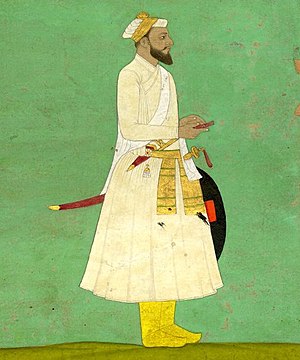
Back شايسته خان Arabic শায়েস্তা খাঁ Bengali/Bangla シャーイスタ・ハーン Japanese 샤이스타 칸 Korean शाहिस्तेखान Marathi Шаиста-хан Russian சயிஸ்ட கான் Tamil Şayeste Han Turkish شائستہ خان Urdu 沙伊斯塔汗 Chinese
| Mirza Abu-Talib Shaista Khan | |||||
|---|---|---|---|---|---|
| Amir-ul-Umara Mughal Subahdar | |||||
 Shaista Khan in c. 1650 | |||||
| 24th & 27th Subahdar of Bengal | |||||
| 1st Governorship | 30 March 1664 – 1676 | ||||
| Predecessor | Mir Jumla II | ||||
| Successor | Fidai Khan II | ||||
| 2nd Governorship | 1680 – 1688 | ||||
| Predecessor | Azam Shah | ||||
| Successor | Ibrahim Khan II | ||||
| Badshah | Aurangzeb | ||||
| Subahdar of Khandesh Subah | |||||
| Governorship | 1658 – 1669 | ||||
| Badshah | Aurangzeb | ||||
| Viceroy of the Deccan | |||||
| Governorship | January 1660 – mid-January 1664 | ||||
| Badshah | Aurangzeb | ||||
| Born | 22 November 1600 Delhi, Mughal Empire | ||||
| Died | c. 1694 (aged 93–94) Delhi, Mughal Empire | ||||
| Issue | Buzurg Umed Khan[1] Iran Dukht Rahmat Banu (Bibi Pari)[2] Aqidat Khan Jafar Khan Abu Nasr Khan Iradat Khan[3] | ||||
| |||||
| Father | Asaf Khan IV | ||||
| Mother | Diwanji Begum | ||||
| Religion | Sunni Islam (Hanafi) | ||||
| Occupation | Mughal Statesman | ||||
Mirza Abu Talib (b. 22 November 1600 – d. 1694),[4][5] better known as Shaista Khan, was a general and the Subahdar of Mughal Bengal, he was maternal uncle to the Mughal Emperor Aurangzeb,[6] he acted as a key figure during his reign, Shaista Khan initially governed the Deccan, where he clashed with the Maratha ruler Shivaji, However, he was most notable for his tenure as the governor of Bengal from 1664 to 1688, Under Shaista Khan's authority, the city of Dhaka and Mughal power in the province attained its greatest heights. His achievements include constructions of notable mosques such as the Sat Gambuj Mosque and masterminding the conquest of Chittagong. Shaista Khan was also responsible for sparking the outbreak of the Anglo-Mughal War with the English East India Company.[7]
- ^ Hossain, AKM Yakub & Haque, AKM Khademul (2012). "Buzurg Umed Khan". In Sirajul Islam; Miah, Sajahan; Khanam, Mahfuza; Ahmed, Sabbir (eds.). Banglapedia: the National Encyclopedia of Bangladesh (Online ed.). Dhaka, Bangladesh: Banglapedia Trust, Asiatic Society of Bangladesh. ISBN 984-32-0576-6. OCLC 52727562. OL 30677644M. Retrieved 27 January 2025.
{{cite encyclopedia}}: CS1 maint: multiple names: authors list (link) - ^ Hossain, AKM Yakub & Chowdhury, AM (2012). "Bibi Pari". In Sirajul Islam; Miah, Sajahan; Khanam, Mahfuza; Ahmed, Sabbir (eds.). Banglapedia: the National Encyclopedia of Bangladesh (Online ed.). Dhaka, Bangladesh: Banglapedia Trust, Asiatic Society of Bangladesh. ISBN 984-32-0576-6. OCLC 52727562. OL 30677644M. Retrieved 27 January 2025.
{{cite encyclopedia}}: CS1 maint: multiple names: authors list (link) - ^ Abdul Karim (2012). "Iranians, The". In Sirajul Islam; Miah, Sajahan; Khanam, Mahfuza; Ahmed, Sabbir (eds.). Banglapedia: the National Encyclopedia of Bangladesh (Online ed.). Dhaka, Bangladesh: Banglapedia Trust, Asiatic Society of Bangladesh. ISBN 984-32-0576-6. OCLC 52727562. OL 30677644M. Retrieved 27 January 2025.
- ^ Cite error: The named reference
hedges_meets_khanwas invoked but never defined (see the help page). - ^ Sir Jadunath Sarkar, History of Aurangzib: Mainly Based on Persian Sources, Volume 5 (1974), p. 283
- ^ Samaren Roy (May 2005). Calcutta: Society and Change 1690–1990. iUniverse. pp. 52–. ISBN 978-0-595-34230-3. Retrieved 25 February 2012.
- ^ Hasan, Farhat (1991). "Conflict and Cooperation in Anglo-Mughal Trade Relations during the Reign of Aurangzeb". Journal of the Economic and Social History of the Orient. 34 (4): 351–360. doi:10.1163/156852091X00058. JSTOR 3632456.